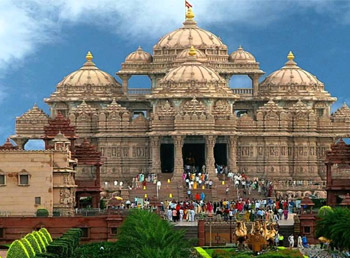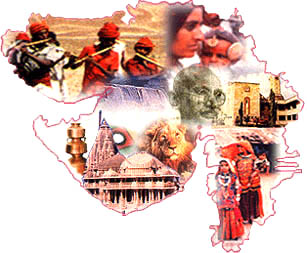
 Mostly visited for – Gandhinagar (capital of Gujarat and famous for original Akshardham Temple), Ahmedabad (Manchester of the East known for its textile mills), Modhera (the site of a beautiful Sun Temple), Patan (known for its intricate showcase of Forts, Step Wells and Lakes), Vadodara (cultural capital of Gujarat), Anand (green countryside and epicenter of white revolution / milk cooperatives), Surat (textiles, diamonds and bejeweled tourist attractions), Saurashtra (center of India’s oldest civilization), Junagadh (a kingdom famous for Asokan Edicts and Mount Girnar), Somnath (a sacred region dedicated to Lord Shiva as a Jyotirlinga), Jamnagar (Oil City of India), Dwarka (kingdom of Lord Krishna), Porbandar (Sabarmati Ashram of Mahatma Gandhi), Saputara (A picturesque Sahyadri hill station)
Mostly visited for – Gandhinagar (capital of Gujarat and famous for original Akshardham Temple), Ahmedabad (Manchester of the East known for its textile mills), Modhera (the site of a beautiful Sun Temple), Patan (known for its intricate showcase of Forts, Step Wells and Lakes), Vadodara (cultural capital of Gujarat), Anand (green countryside and epicenter of white revolution / milk cooperatives), Surat (textiles, diamonds and bejeweled tourist attractions), Saurashtra (center of India’s oldest civilization), Junagadh (a kingdom famous for Asokan Edicts and Mount Girnar), Somnath (a sacred region dedicated to Lord Shiva as a Jyotirlinga), Jamnagar (Oil City of India), Dwarka (kingdom of Lord Krishna), Porbandar (Sabarmati Ashram of Mahatma Gandhi), Saputara (A picturesque Sahyadri hill station)
Adventure - Horse Safari in Ahmedabad, Danta, Dasada, Wankaner, Gondal, Vadodara; Camel Safari can be cherished in the white deserts of Kachchh and Trekking can be enjoyed at Saputara to Ahwa, Dhrangadra and Banni.
Weather - Summer: March to May, Monsoon: June to September, Winter: October to February. Climate of Gujarat is diverse in nature, owing to its presence near Arabian Sea making the summers clear and winters mildly pleasant.
Connectivity
By Air – The state of Gujarat has 10 domestic airports and an international airport at Ahmedabad.
By Rail- Extensive railway network runs through the state of Gujarat. The state is served by several important trains.
By Road – The roadway network of 68,900 km comprising National Highways, State Highways and other roads run through the state connecting the major cities of the state with the rest of the country.
History, Geography and Culture of Gujarat
The land of the legends, Gujarat is a vibrant state of  incredible India known worldwide for many reasons. For many centuries, this land epitomized the riches and resources synonymous to India. One such prime reason is its rich share of history. In ancient times, this westernmost land of India was an active part of Indus Valley Civilization (Harappan Civilization), the world's earliest urban civilizations. The acumen and ahead of the mind approach of these inhabitants can be witnessed and observed via the ruins of Dholavira, Lothal and Surkotba in Gujarat. The long monumental and cultural sequence of heritage of meticulously planned city, Dholavira can be traced back to 3rd century BC. Famed for its immaculate planning spread over an area of 100 acres, this is one of the two largest settlements in India. This glorious site enjoys the unique distinction of yielding an inscription in the form of oldest sign board of the world (featuring 10 large sized signs of the Harappan script). The highlights of the remains can be characterized with the mathematical precision of multi-storeyed houses, monumental architecture, and number of reservoirs for water management reflects the practical mindset behind Dholavira.
incredible India known worldwide for many reasons. For many centuries, this land epitomized the riches and resources synonymous to India. One such prime reason is its rich share of history. In ancient times, this westernmost land of India was an active part of Indus Valley Civilization (Harappan Civilization), the world's earliest urban civilizations. The acumen and ahead of the mind approach of these inhabitants can be witnessed and observed via the ruins of Dholavira, Lothal and Surkotba in Gujarat. The long monumental and cultural sequence of heritage of meticulously planned city, Dholavira can be traced back to 3rd century BC. Famed for its immaculate planning spread over an area of 100 acres, this is one of the two largest settlements in India. This glorious site enjoys the unique distinction of yielding an inscription in the form of oldest sign board of the world (featuring 10 large sized signs of the Harappan script). The highlights of the remains can be characterized with the mathematical precision of multi-storeyed houses, monumental architecture, and number of reservoirs for water management reflects the practical mindset behind Dholavira.
Lothal, another Indus Valley Site was world’s earliest known dock ensured the connectivity of Harappan civilization to the ancient trade route between Sindh, the peninsula of Saurashtra with the other contemporary civilizations (Mesopotamia and Ancient Egypt). This was a major exchange and trade point of this civilization. Another renowned site in the region is Surkotda, which came into existence n 2,300 BC with a fortified citadel and mud brick residential settlement. Likewise, there were 50 settlement ruins discovered in Gujarat.
The glory of the region under modern day Gujarat was the reason why Mahmud Ghaznavi attacked this region and looted away the riches eleven times. According to Hindu mythology, the region as Dwarka was ruled by Lord Krishna, an incarnation of Lord Vishnu. A temple which is worshipped as a part of Char Dham Pilgrimage speaks Lord Krishna’s sojourn here. Other than that, the state was the birthplace of Mahatma Gandhi (Porbandar) and Sardar Vallabhbhai Patel (Nadiad) who later became the shapers of modern India free from British rule.
Geographically, this peninsular state shares its northwest borders with Sindh in Pakistan, Arabian Sea to the southwest, Rajasthan to the northeast, Madhya Pradesh to the east, and by Maharashtra, Union territories of Diu, Daman, Dadra and Nagar Haveli to the south. Owing to its presence adjacent to Arabian Sea, the state has the longest coastline (1600 km), dotted with 41 ports. Three rivers namely Sabarmati, Tapi and Narmada feed the region.
The deserted region of Rann of Kutch is a home to the wild ass and Gir forest is the habitat for Asiatic Lion. The state’s economy is primarily characterized by its textile mills and oil refineries, contributing to its sheer wealth. Its prime agricultural produce includes cotton, groundnuts, dates, sugarcane, milk & milk products.
The culture of Gujarat is rich, colourful and artistic. This state is flourishing and prosperous in terms of its traditions and culture as well. Besides a sizeable population of Hindus and Muslims, Tribes also form a major cultural element of the region. There are Jats, Gurjars, Harijans, Ahirs and Rabaris, etc representing the tribes and their artistic tribal traditions and craftsmanship.
Religion – Hinduism, Islam, Jainism, Buddhism, Christianity and Zoroastrianism
Wildlife Sanctuaries of Gujarat
Gir Forest National Park
Blackbuck National Park
The Little Rann
Marine National Park (near Jamnagar)
Wild Ass National Park
Sasangir Wildlife Sanctuary
Nal Sarovar Bird Sanctuary
Barda Wildlife Sanctuary
Kachchh Desert Wildlife Sanctuary
Festivals
International Kite Festival - Makar Sakranti (Jan)
Modhera Dance Festival (Jan)
Bhavnath Fair (Jan/Feb; Junagadh)
Dhrang Mela (Feb/Mar)
Dang Durbar (Feb/Mar; The Dangs, east of Surat,)
Vautha Livestock Fair (Mar/Apr)
Mahakali (Mar/Apr; Pavagadh)
Gokulashtami (Aug – Lord Krishna’s Birthday)
Bhadra Purnima Fair (Aug/Sept)
Tarnetar Fair (Sep)
Trinetreshwer Mahadev Fair (Aug/Sept)
Navratri (Oct)
Dussehra (Sep/Oct; statewide)
Kartik Purnima Fair (Nov)
Vautha Mela
Sanskruti Kunj Fair
Chota Udaipur Tribal Fairs
Rann Utsav (Dec)
Eat – Primarily vegetarian, the cuisine from Gujarat is mild as well as flavoured. There is a flavoured mishmash of sweet, salt and spices, making it a concoction of varied tastes. Dhokla, Khandvi, Patra, Khichu, Sev Khamani, Lilva Kachori, Daal Dhokli, Fulka rotli, Thepla, Bhakhri, Undhiyun, Sev Tametanu Shaak and Khaman comprise the known cuisines of Gujarat.
Buy – The colourful region of Gujarat has its unique colours in terms of its souvenirs and crafts. Tourists must buy back authentic hand block printed Bandhej (tie and dye dupatta / saree), Matani, Jari, Mashru Fabric as textile treasures of Gujarat. Female tourists must not miss purchasing Ghaghra Choli (traditional Gujarati Dress), Toran, Patola, Lacquer Work, Wood Carving, Pottery and Dhurries during Gujarat Tour.
Hotels – There are a number of heritage hotels and resorts that strengthen the hospitality circuit and promise tourists a great reason to holiday in Gujarat’s luxury, beauty and comfort.
